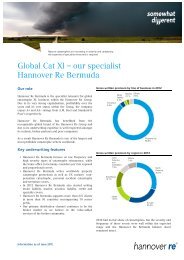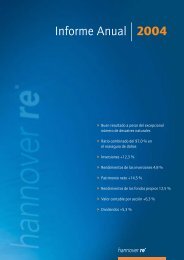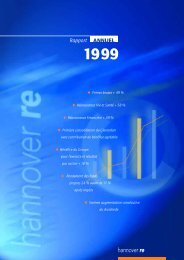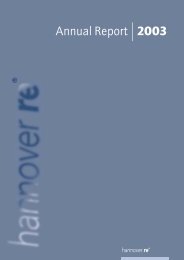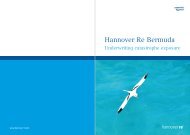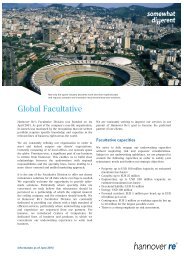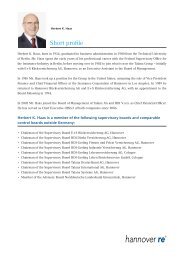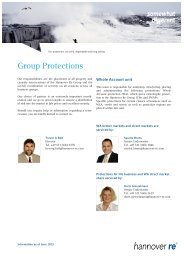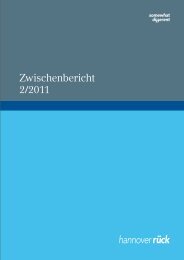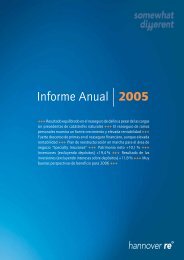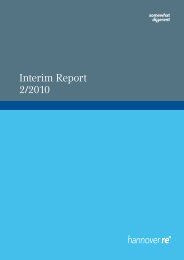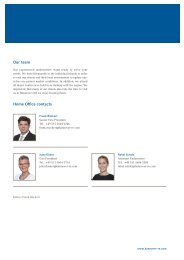Annual Report 2010 - Hannover Re
Annual Report 2010 - Hannover Re
Annual Report 2010 - Hannover Re
You also want an ePaper? Increase the reach of your titles
YUMPU automatically turns print PDFs into web optimized ePapers that Google loves.
3.3 Segmentation<br />
<strong>Hannover</strong> <strong>Re</strong>‘s segmental report is based on IFRS 8 “Operating<br />
Segments” and on the principles set out in German<br />
Accounting Standard No. 3 “Segment <strong><strong>Re</strong>port</strong>ing” (DRS 3) of<br />
the German Accounting Standards Board as well as the requirements<br />
of DRS 3–20 “Segment <strong><strong>Re</strong>port</strong>ing of Insurance<br />
Enterprises”.<br />
The segmentation in non-life reinsurance and life/health reinsurance<br />
and the segment information presented follow the<br />
system used for internal reporting purposes, on the basis of<br />
which the full Executive Board regularly evaluates the performance<br />
of the segments and decides on the allocation of<br />
resources to the segments.<br />
During the financial year no material changes occurred in the<br />
organisational structure that could have influenced the composition<br />
of the segments. Since the performance indicators<br />
used to steer the segments correspond to the system according<br />
to which the consolidated financial statement is prepared,<br />
a separate reconciliation of the segment results with the Group<br />
result is not provided.<br />
3.4 Major discretionary decisions and estimates<br />
In the consolidated financial statement it is to some extent<br />
necessary to make estimates and assumptions which affect<br />
the assets and liabilities shown in the balance sheet, the information<br />
on contingent claims and liabilities as at the balance<br />
sheet date and the disclosure of income and expenses during<br />
the reporting period. Key facts and circumstances subject<br />
to such assumptions and estimates include, for example, the<br />
recoverability of contingent reinsurance liabilities, the valuation<br />
of derivative financial instruments as well as assets and<br />
liabilities relating to employee benefits. The actual amounts<br />
may diverge from the estimated amounts.<br />
Measurement of the obligations existing in this connection is<br />
carried out using a separate process, which is based largely<br />
on contract-specific estimates.<br />
For further details, for example concerning the modelling of<br />
natural catastrophe scenarios and the assumptions relating to<br />
asbestos and pollution risks, the reader is referred to our comments<br />
in the risk report on page 60 et seq. We would further<br />
refer to our explanatory remarks on the technical reserves in<br />
Section 3.2 “Summary of major accounting policies” and Section<br />
5.7 “Technical provisions”.<br />
In order to measure the “ultimate liability” in non-life business<br />
the expected ultimate loss ratios are calculated for all<br />
lines. Actuarial methods such as the “chain ladder” method<br />
provide the starting point for these calculations. The best possible<br />
estimated future settlement amount is recognised in the<br />
balance sheet. The development until completion of the runoff<br />
is projected on the basis of statistical triangles from the<br />
original notifications of ceding companies. In this context it<br />
is generally assumed that the future rate of inflation of the<br />
loss run-off will be analogous to the average rate of the past<br />
inflation contained in the data. The more recent underwriting<br />
years in actuarial projections are of course subject to greater<br />
uncertainty, although this can be considerably reduced with<br />
the aid of a variety of additional information on improvements<br />
in the rates and conditions of the business written and on loss<br />
trends. The amounts arrived at as the difference between the<br />
ultimate losses and the reported losses are set aside as the<br />
IBNR reserve for losses that have been incurred but are not<br />
yet known or have still to be reported.<br />
By analysing a broad range of observable information it is<br />
possible to classify losses as major individual loss events.<br />
In life business too the calculation of reserves and assets is<br />
crucially dependent on actuarial projections of the covered<br />
business. So-called model points are defined according to the<br />
type of business covered. The main distinguishing criter ia are<br />
the age, sex and (non-)smoker status of the insured, tariff, policy<br />
period, period of premium payment and amount of insurance.<br />
The portfolio development is simulated for each model<br />
point, in which regard the key input parameters are either<br />
predefined by the tariff (e.g. allowance for costs, amount of<br />
premium, actuarial interest rate) or need to be estimated (e.g.<br />
mortality or disability rates, lapse rates). These assumptions<br />
are heavily dependent on country-specific parameters and on<br />
the sales channel, quality of the cedant‘s underwriting and<br />
claims handling, type of reinsurance and other framework<br />
conditions of the reinsurance treaty. The superimposition<br />
of numerous model points gives rise to a projection, which<br />
incorp orates inter alia assumptions concerning the port folio<br />
composition and the commencement of covered policies within<br />
the year. Such assumptions are estimated at the inception of<br />
a reinsurance treaty and subsequently adjusted to the actual<br />
projection.<br />
122 NOTES 3.4 Major discretionary decisions and estimates<br />
<strong>Hannover</strong> <strong>Re</strong> Group annual report <strong>2010</strong>



